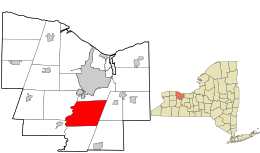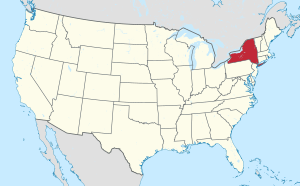Henrietta, New York facts for kids
Quick facts for kids
Henrietta
|
|
|---|---|

Town hall
|
|

Location in Monroe County and the state of New York.
|
|

Location of New York in the United States
|
|
| Country | United States |
| State | New York |
| County | Monroe |
| Established | March 27, 1818 |
| Area | |
| • Total | 35.65 sq mi (92.32 km2) |
| • Land | 35.35 sq mi (91.56 km2) |
| • Water | 0.30 sq mi (0.77 km2) |
| Elevation | 600 ft (200 m) |
| Population
(2020)
|
|
| • Total | 47,096 |
| • Density | 1,332.28/sq mi (514.37/km2) |
| Time zone | UTC-5 (EST) |
| • Summer (DST) | UTC-4 (EDT) |
| ZIP code |
14467, 14534 ,14586, 14623
|
| Area code(s) | 585 |
| FIPS code | 36-055-34099 |
Henrietta is a town in Monroe County, New York. It's a suburb of the city of Rochester. About 47,096 people live in Henrietta, according to the 2020 United States census. Henrietta is home to the Rochester Institute of Technology and has one of the biggest shopping areas in Monroe County.
Contents
Henrietta's History
Early Settlers and Native Americans
Long ago, Native Americans lived in the Henrietta area. While no villages have been found, farmers and archeologists have discovered many old tools and remains over the past 200 years. After the American Revolution, some Native American tribes had to leave Upstate New York. This made land available for European settlers in the Finger Lakes and Genesee Valley regions.
How Henrietta Got Its Name
The town of Henrietta was named after a British noblewoman, Henrietta Laura Pulteney. Her father, Sir William Pulteney, 5th Baronet, was a major British investor who owned the land that became the town. Henrietta Pulteney herself never actually visited the town.
Founding the Town
The first European settlers in Henrietta were Major Ezekiel Scott and his wife Catherine. They bought 900 acres of land in 1790. Most of the early settlers were English. Two small villages, East and West Henrietta, grew in the area. Both were part of the Town of Pittsford. In 1818, the people of these two villages decided to form their own town, called Henrietta.
Growth and Development
When the Erie Canal opened in 1825, farmers in Henrietta could easily send their crops to New York City. This helped the town grow and become successful. In 1826, the Monroe Academy opened in Henrietta. It was the first official school in Monroe County.
After World War II, many people moved from Rochester to Henrietta. The town's population quickly grew from 3,000 to about 14,000 in just ten years. The building of the New York Thruway in the early 1950s also made Henrietta a great place for businesses to grow.
In 1968, the Rochester Institute of Technology (RIT) moved its campus to Henrietta. The National Technical Institute for the Deaf also opened there that same year. In the 1980s, with new highways and the building of the Marketplace Mall, Henrietta became a major shopping spot in Monroe County.
Historic Places in Henrietta
Henrietta has several places listed on the National Register of Historic Places. These are important sites that are protected for their history:
- Andrew Short House
- Antoinette Louisa Brown Blackwell Childhood Home
- Tinker Cobblestone Farmstead
Henrietta's Geography
Henrietta is located in Monroe County. It shares borders with several other towns:
- To the west, the Genesee River separates Henrietta from the towns of Chili and Wheatland.
- To the north, Henrietta borders the town of Brighton. The city of Rochester is also north of Henrietta, but they don't share a direct border.
- To the east, you'll find the towns of Pittsford and Mendon.
- To the south, Henrietta borders the town of Rush.
The total area of Henrietta is about 35.6 square miles (92.3 square kilometers). Most of this is land, with a small amount of water.
Transportation and Waterways
Two major highways, the New York Thruway (Interstate 90) and Interstate 390, pass through Henrietta. A small part of the Erie Canal also runs through the northeastern side of the town.
Henrietta's Population
As of 2020, the population of Henrietta was 47,096 people.
Population Changes Over Time
Henrietta's population has grown a lot over the years. Here's a look at how it has changed:
| Historical population | |||
|---|---|---|---|
| Census | Pop. | %± | |
| 1820 | 2,181 | — | |
| 1830 | 2,310 | 5.9% | |
| 1840 | 2,085 | −9.7% | |
| 1850 | 2,513 | 20.5% | |
| 1860 | 2,249 | −10.5% | |
| 1870 | 2,280 | 1.4% | |
| 1880 | 2,243 | −1.6% | |
| 1890 | 2,135 | −4.8% | |
| 1900 | 2,062 | −3.4% | |
| 1910 | 1,972 | −4.4% | |
| 1920 | 1,794 | −9.0% | |
| 1930 | 2,142 | 19.4% | |
| 1940 | 2,728 | 27.4% | |
| 1950 | 3,385 | 24.1% | |
| 1960 | 11,598 | 242.6% | |
| 1970 | 33,017 | 184.7% | |
| 1980 | 36,134 | 9.4% | |
| 1990 | 36,376 | 0.7% | |
| 2000 | 39,028 | 7.3% | |
| 2010 | 42,581 | 9.1% | |
| 2020 | 47,096 | 10.6% | |
| U.S. Decennial Census | |||
Diversity in Henrietta
According to a survey from 2005-2009, the people living in Henrietta included:
- 81.5% White
- 7.9% African American
- 5.9% Asian
- 3.1% Hispanic or Latino
- 0.27% Native American
- 1.4% other groups
Communities in Henrietta
Henrietta has several distinct areas:
East Henrietta
The hamlet of East Henrietta is found where East Henrietta Road (New York State Route 15A) and Lehigh Station Road (New York State Route 253) meet. This was once the home of the Monroe Academy, the first high school in the county. It later became Rush-Henrietta Senior High School. The historic Kirby House, a beautiful example of Greek Revival architecture, was also located here before being moved to a different neighborhood.
West Henrietta
The hamlet of West Henrietta is located at the intersection of West Henrietta Road (Route 15) and Erie Station Road. This area has several old buildings:
- The West Henrietta Baptist Church, built in 1838.
- The West Henrietta Post Office/West Henrietta Fire Department building, which was a schoolhouse in the 1920s.
- A former general store building from 1906, now a pizza restaurant.
- The old Cartwright Inn building, which started as a tavern in 1831.
Riverton
Riverton is a special community that was planned and built by the federal government in 1973.
Education in Henrietta
Henrietta is a hub for education, with several important schools and universities.
Universities
Schools and Institutes
- Bryant & Stratton College
- Rush-Henrietta Central School District
- School of the Holy Childhood - This is a non-profit organization that helps people with developmental disabilities.
- The Norman Howard School - A day school for children with disabilities.
- Continental School of Beauty
- Aab Cardiovascular Research Institute (part of the University of Rochester)
Notable People from Henrietta
Many interesting people have connections to Henrietta, including:
- Joseph L. Biehler, a U.S. Army major general.
- John Birdsell, who invented the Birdsell Clover Huller and started the Birdsell Manufacturing Company.
- Antoinette Brown Blackwell, known for being the first ordained female minister in the United States.
- Shenise Johnson, a professional WNBA basketball player.
- Samantha Watson, a talented middle-distance runner.
See also
 In Spanish: Henrietta (Nueva York) para niños
In Spanish: Henrietta (Nueva York) para niños

